Report: Assessing Health and Safety Culture in the USG Company
VerifiedAdded on 2022/08/26
|15
|3692
|17
Report
AI Summary
This report presents an assessment of the health and safety culture within United Security Group (USG), a security services provider. The assessment focuses on the existing human resource policies related to workplace and occupational health and safety compliance. The methodology includes a cross-sectional descriptive research design, employing a self-developed survey questionnaire distributed to 50 employees. The survey tool covered hazard management, shift ergonomics, workplace environment, compensation, and training. Data analysis involved percentage distribution for nominal data and descriptive statistics for ordinal data. The report analyzes participant demographics (gender, experience) and provides detailed results for each health and safety aspect, including hazard inspection, safety in the workplace, ergonomics, workplace culture, compensation, and training. Findings from the data analysis reveal gaps in the existing human resource management system and form the basis for future improvement plans. The assessment aims to identify areas for enhancement in USG's health and safety practices.

Part 3 Assessment of Health and Safety Cultures
Introduction
Assessment of health and safety culture within a human resource management system of an
organisation implies the procedures of collecting data regarding health and safety related
policies in that particular organisation and analysing the data for finding the gap in the
current human resource management system of that particular organisation. The purpose of
this assessment section is to assess the existing human resource policies associated with
workplace and occupational health and safety compliance within United Security Group or
USG. As a guarding services provider organisation, the occupational health and safety
concern of USG Company includes various aspects of occupational health and safety related
concerns including hazard management, environment management, workforce culture,
compensation system, employer’s health and safety obligations, employees health and safety
obligations, emergency policies and others. In order to assess all of this concerns this section
of this paper has been developed. The paper has three major conceptual sections namely
discussion of the assessment method, analysis and results development and finally the
forming of implications. In the following section of this paper the conceptual part of utilised
method for health and safety human resource policy assessment has been presented along
with practical aspects of the data collection and data analysis procedures. After that, the
analysis has been done as per the discussed data analysis methodology and the final
implications have been developed form the data analysis and results section. Based on the
findings of the found in this section the improvement plan will be developed for the human
resource management system of USG Company.
Introduction
Assessment of health and safety culture within a human resource management system of an
organisation implies the procedures of collecting data regarding health and safety related
policies in that particular organisation and analysing the data for finding the gap in the
current human resource management system of that particular organisation. The purpose of
this assessment section is to assess the existing human resource policies associated with
workplace and occupational health and safety compliance within United Security Group or
USG. As a guarding services provider organisation, the occupational health and safety
concern of USG Company includes various aspects of occupational health and safety related
concerns including hazard management, environment management, workforce culture,
compensation system, employer’s health and safety obligations, employees health and safety
obligations, emergency policies and others. In order to assess all of this concerns this section
of this paper has been developed. The paper has three major conceptual sections namely
discussion of the assessment method, analysis and results development and finally the
forming of implications. In the following section of this paper the conceptual part of utilised
method for health and safety human resource policy assessment has been presented along
with practical aspects of the data collection and data analysis procedures. After that, the
analysis has been done as per the discussed data analysis methodology and the final
implications have been developed form the data analysis and results section. Based on the
findings of the found in this section the improvement plan will be developed for the human
resource management system of USG Company.
Paraphrase This Document
Need a fresh take? Get an instant paraphrase of this document with our AI Paraphraser
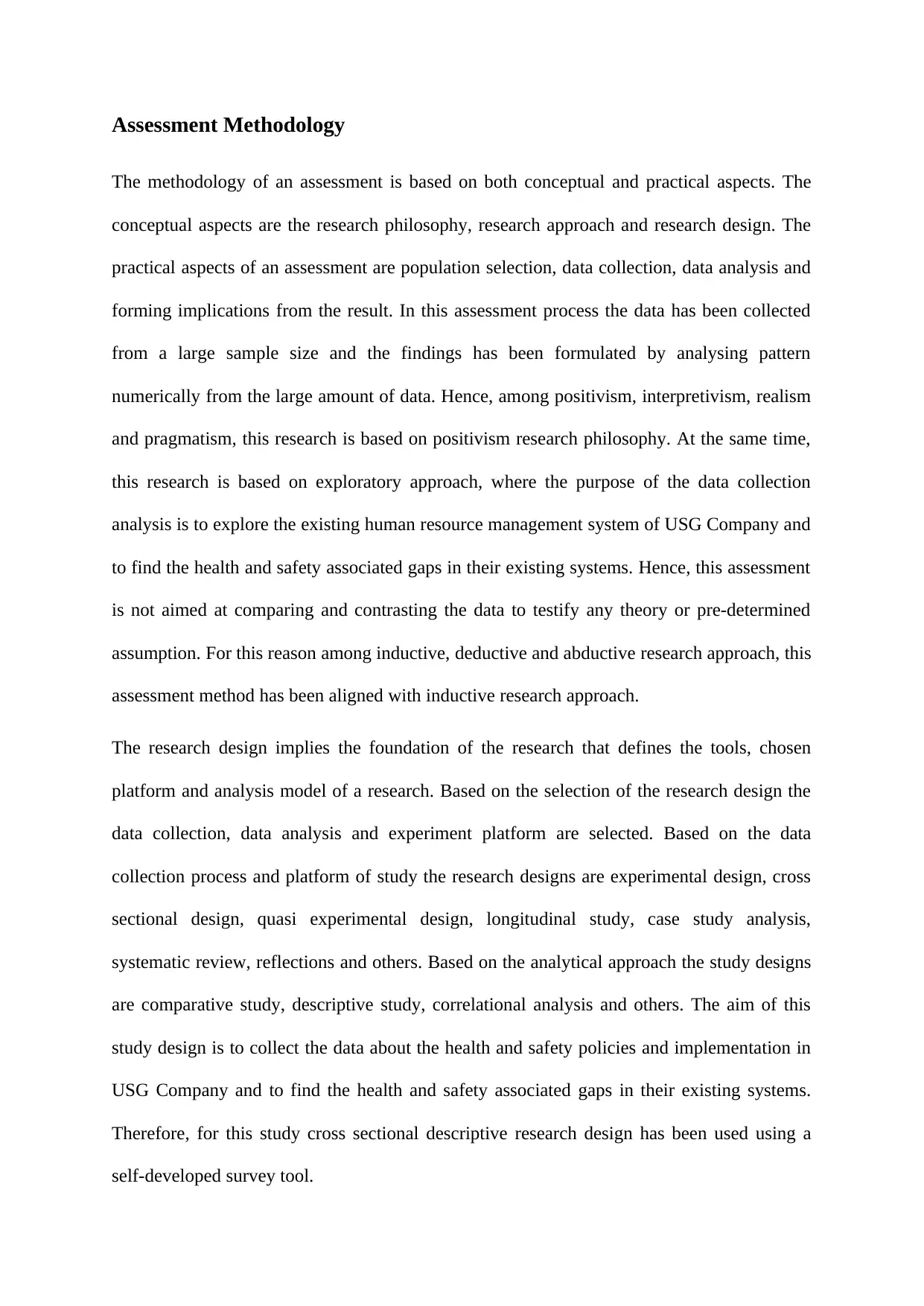
Assessment Methodology
The methodology of an assessment is based on both conceptual and practical aspects. The
conceptual aspects are the research philosophy, research approach and research design. The
practical aspects of an assessment are population selection, data collection, data analysis and
forming implications from the result. In this assessment process the data has been collected
from a large sample size and the findings has been formulated by analysing pattern
numerically from the large amount of data. Hence, among positivism, interpretivism, realism
and pragmatism, this research is based on positivism research philosophy. At the same time,
this research is based on exploratory approach, where the purpose of the data collection
analysis is to explore the existing human resource management system of USG Company and
to find the health and safety associated gaps in their existing systems. Hence, this assessment
is not aimed at comparing and contrasting the data to testify any theory or pre-determined
assumption. For this reason among inductive, deductive and abductive research approach, this
assessment method has been aligned with inductive research approach.
The research design implies the foundation of the research that defines the tools, chosen
platform and analysis model of a research. Based on the selection of the research design the
data collection, data analysis and experiment platform are selected. Based on the data
collection process and platform of study the research designs are experimental design, cross
sectional design, quasi experimental design, longitudinal study, case study analysis,
systematic review, reflections and others. Based on the analytical approach the study designs
are comparative study, descriptive study, correlational analysis and others. The aim of this
study design is to collect the data about the health and safety policies and implementation in
USG Company and to find the health and safety associated gaps in their existing systems.
Therefore, for this study cross sectional descriptive research design has been used using a
self-developed survey tool.
The methodology of an assessment is based on both conceptual and practical aspects. The
conceptual aspects are the research philosophy, research approach and research design. The
practical aspects of an assessment are population selection, data collection, data analysis and
forming implications from the result. In this assessment process the data has been collected
from a large sample size and the findings has been formulated by analysing pattern
numerically from the large amount of data. Hence, among positivism, interpretivism, realism
and pragmatism, this research is based on positivism research philosophy. At the same time,
this research is based on exploratory approach, where the purpose of the data collection
analysis is to explore the existing human resource management system of USG Company and
to find the health and safety associated gaps in their existing systems. Hence, this assessment
is not aimed at comparing and contrasting the data to testify any theory or pre-determined
assumption. For this reason among inductive, deductive and abductive research approach, this
assessment method has been aligned with inductive research approach.
The research design implies the foundation of the research that defines the tools, chosen
platform and analysis model of a research. Based on the selection of the research design the
data collection, data analysis and experiment platform are selected. Based on the data
collection process and platform of study the research designs are experimental design, cross
sectional design, quasi experimental design, longitudinal study, case study analysis,
systematic review, reflections and others. Based on the analytical approach the study designs
are comparative study, descriptive study, correlational analysis and others. The aim of this
study design is to collect the data about the health and safety policies and implementation in
USG Company and to find the health and safety associated gaps in their existing systems.
Therefore, for this study cross sectional descriptive research design has been used using a
self-developed survey tool.
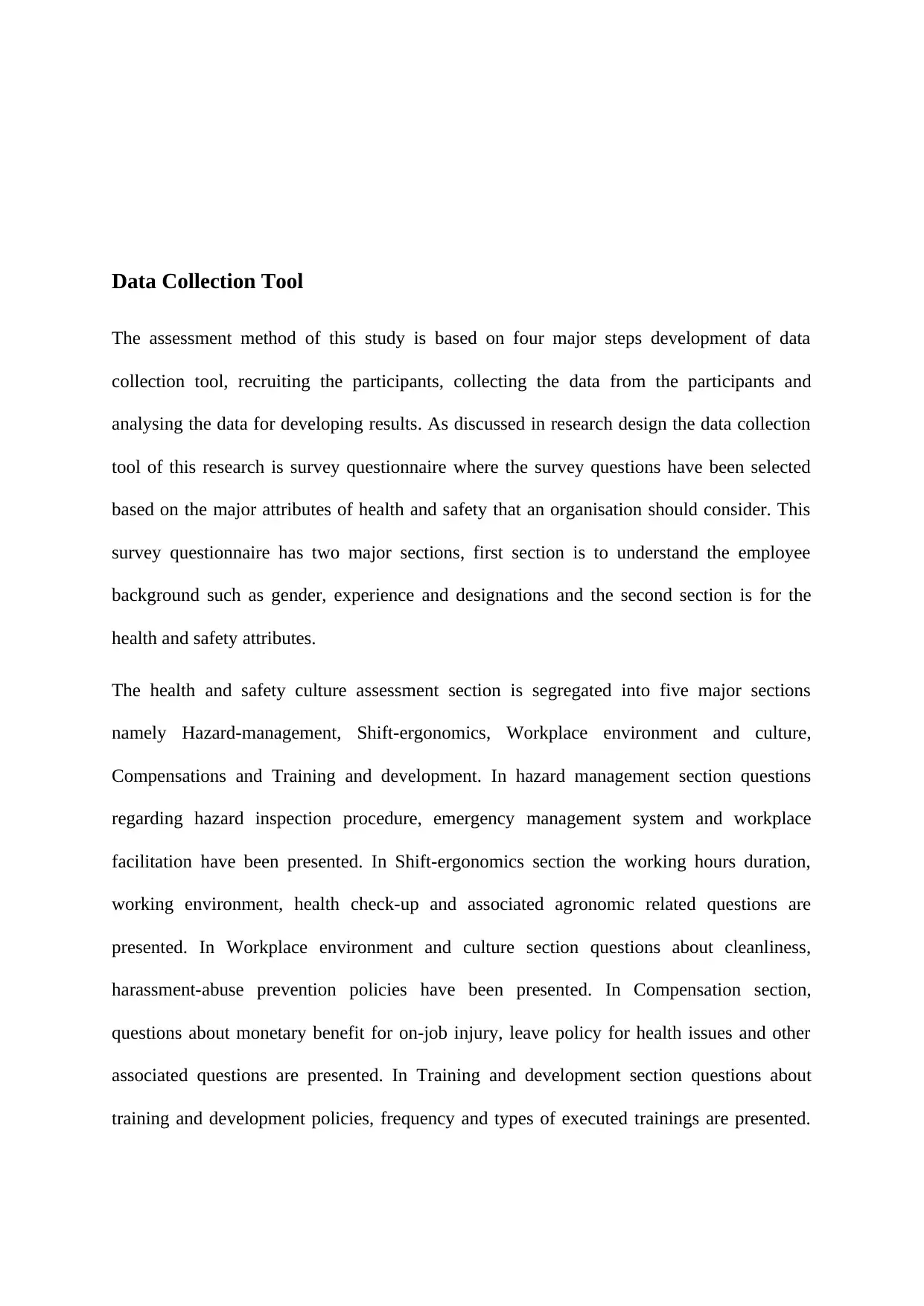
Data Collection Tool
The assessment method of this study is based on four major steps development of data
collection tool, recruiting the participants, collecting the data from the participants and
analysing the data for developing results. As discussed in research design the data collection
tool of this research is survey questionnaire where the survey questions have been selected
based on the major attributes of health and safety that an organisation should consider. This
survey questionnaire has two major sections, first section is to understand the employee
background such as gender, experience and designations and the second section is for the
health and safety attributes.
The health and safety culture assessment section is segregated into five major sections
namely Hazard-management, Shift-ergonomics, Workplace environment and culture,
Compensations and Training and development. In hazard management section questions
regarding hazard inspection procedure, emergency management system and workplace
facilitation have been presented. In Shift-ergonomics section the working hours duration,
working environment, health check-up and associated agronomic related questions are
presented. In Workplace environment and culture section questions about cleanliness,
harassment-abuse prevention policies have been presented. In Compensation section,
questions about monetary benefit for on-job injury, leave policy for health issues and other
associated questions are presented. In Training and development section questions about
training and development policies, frequency and types of executed trainings are presented.
The assessment method of this study is based on four major steps development of data
collection tool, recruiting the participants, collecting the data from the participants and
analysing the data for developing results. As discussed in research design the data collection
tool of this research is survey questionnaire where the survey questions have been selected
based on the major attributes of health and safety that an organisation should consider. This
survey questionnaire has two major sections, first section is to understand the employee
background such as gender, experience and designations and the second section is for the
health and safety attributes.
The health and safety culture assessment section is segregated into five major sections
namely Hazard-management, Shift-ergonomics, Workplace environment and culture,
Compensations and Training and development. In hazard management section questions
regarding hazard inspection procedure, emergency management system and workplace
facilitation have been presented. In Shift-ergonomics section the working hours duration,
working environment, health check-up and associated agronomic related questions are
presented. In Workplace environment and culture section questions about cleanliness,
harassment-abuse prevention policies have been presented. In Compensation section,
questions about monetary benefit for on-job injury, leave policy for health issues and other
associated questions are presented. In Training and development section questions about
training and development policies, frequency and types of executed trainings are presented.
⊘ This is a preview!⊘
Do you want full access?
Subscribe today to unlock all pages.

Trusted by 1+ million students worldwide

In the following section the developed data collection tool has been presented with the
assigned code for identifying the options.
1 Background
1.1 Gender Male Female Other
1.2 Experience Less than 1
years
1 to 2 years 2 to 5
years
5 to 10
years
More than
10 years
1.3 Job Role Guard Leader Manger Other
2 Hazard-management
2.1 How often is hazard
inspection process
executed in office
premise?
Never Rare Sometimes Frequently Highly
frequently
2.2 How safe and secure
is your office place?
Highly
unsafe
Unsafe Moderate
safe
Safe Highly
Safe
2.3 How safe and secure
usually are the areas
you are assigned as
guard?
Highly
unsafe
Unsafe Moderate
safe
Safe Highly
Safe
3 Shift-ergonomics
3.1 How often do you
experience tiring and
prolonged duty ours?
Never Rare Sometimes Frequently Highly
frequently
3.2 How often do you
assigned in such areas
where working
becomes problematic
and tiring?
Never Rare Sometimes Frequently Highly
frequently
3.3 How often do your
organisation run
health check-up for all
the employees?
Never Rare Sometimes Frequently Highly
frequently
4 Workplace
environment and
culture
4.1 How strong and strict
is the workplace
bullying, harassment
and sexual abuse
policies of your
organisation?
Highly weak weak Neither
strong not
weak
Strong Highly
strong
4.2 How often do you
found someone being
bullied, harassed or
abused by some other
worker?
Never Rare Sometimes Frequently Highly
frequently
4.3 How strong and Highly weak weak Neither Strong Highly
assigned code for identifying the options.
1 Background
1.1 Gender Male Female Other
1.2 Experience Less than 1
years
1 to 2 years 2 to 5
years
5 to 10
years
More than
10 years
1.3 Job Role Guard Leader Manger Other
2 Hazard-management
2.1 How often is hazard
inspection process
executed in office
premise?
Never Rare Sometimes Frequently Highly
frequently
2.2 How safe and secure
is your office place?
Highly
unsafe
Unsafe Moderate
safe
Safe Highly
Safe
2.3 How safe and secure
usually are the areas
you are assigned as
guard?
Highly
unsafe
Unsafe Moderate
safe
Safe Highly
Safe
3 Shift-ergonomics
3.1 How often do you
experience tiring and
prolonged duty ours?
Never Rare Sometimes Frequently Highly
frequently
3.2 How often do you
assigned in such areas
where working
becomes problematic
and tiring?
Never Rare Sometimes Frequently Highly
frequently
3.3 How often do your
organisation run
health check-up for all
the employees?
Never Rare Sometimes Frequently Highly
frequently
4 Workplace
environment and
culture
4.1 How strong and strict
is the workplace
bullying, harassment
and sexual abuse
policies of your
organisation?
Highly weak weak Neither
strong not
weak
Strong Highly
strong
4.2 How often do you
found someone being
bullied, harassed or
abused by some other
worker?
Never Rare Sometimes Frequently Highly
frequently
4.3 How strong and Highly weak weak Neither Strong Highly
Paraphrase This Document
Need a fresh take? Get an instant paraphrase of this document with our AI Paraphraser
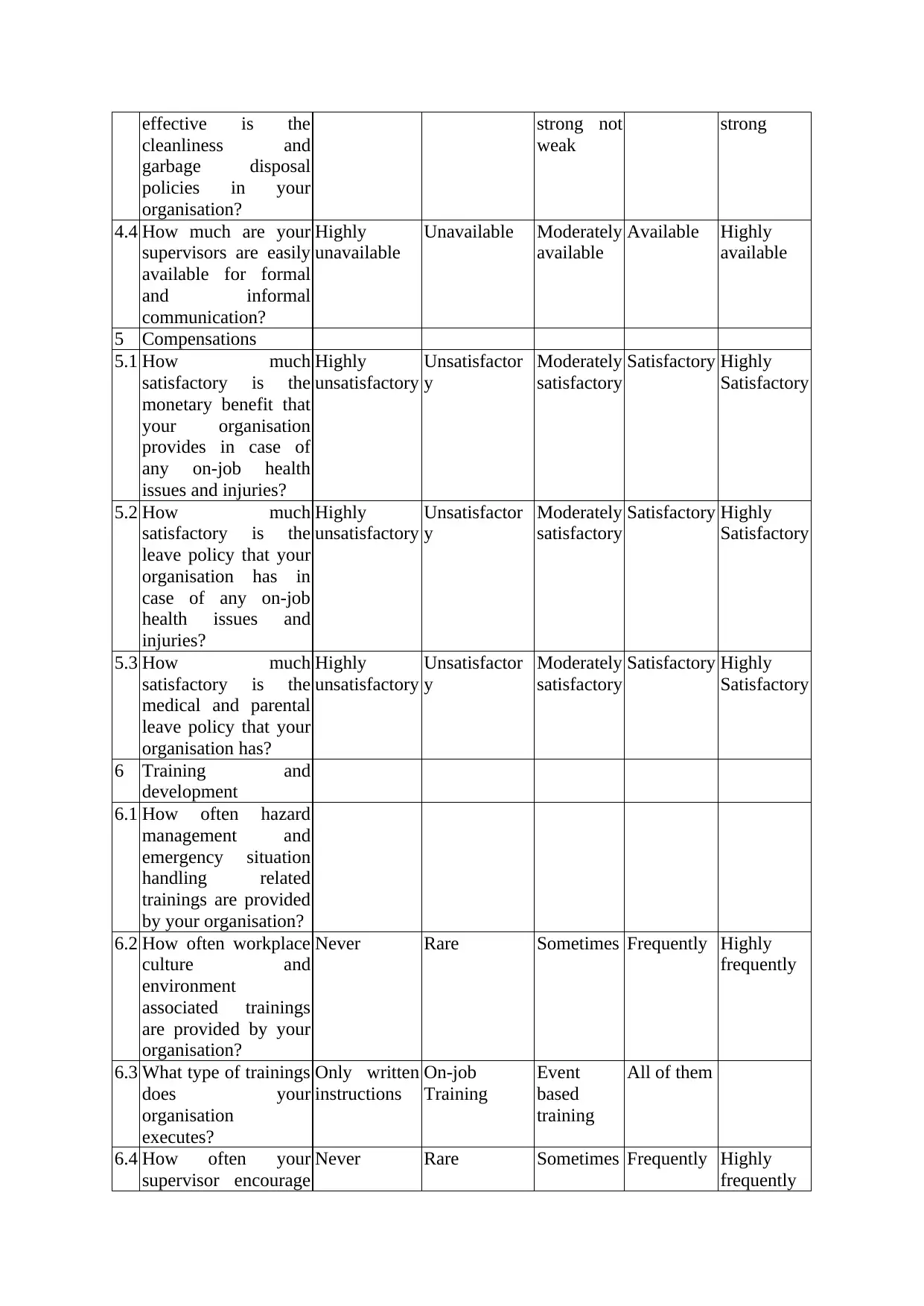
effective is the
cleanliness and
garbage disposal
policies in your
organisation?
strong not
weak
strong
4.4 How much are your
supervisors are easily
available for formal
and informal
communication?
Highly
unavailable
Unavailable Moderately
available
Available Highly
available
5 Compensations
5.1 How much
satisfactory is the
monetary benefit that
your organisation
provides in case of
any on-job health
issues and injuries?
Highly
unsatisfactory
Unsatisfactor
y
Moderately
satisfactory
Satisfactory Highly
Satisfactory
5.2 How much
satisfactory is the
leave policy that your
organisation has in
case of any on-job
health issues and
injuries?
Highly
unsatisfactory
Unsatisfactor
y
Moderately
satisfactory
Satisfactory Highly
Satisfactory
5.3 How much
satisfactory is the
medical and parental
leave policy that your
organisation has?
Highly
unsatisfactory
Unsatisfactor
y
Moderately
satisfactory
Satisfactory Highly
Satisfactory
6 Training and
development
6.1 How often hazard
management and
emergency situation
handling related
trainings are provided
by your organisation?
6.2 How often workplace
culture and
environment
associated trainings
are provided by your
organisation?
Never Rare Sometimes Frequently Highly
frequently
6.3 What type of trainings
does your
organisation
executes?
Only written
instructions
On-job
Training
Event
based
training
All of them
6.4 How often your
supervisor encourage
Never Rare Sometimes Frequently Highly
frequently
cleanliness and
garbage disposal
policies in your
organisation?
strong not
weak
strong
4.4 How much are your
supervisors are easily
available for formal
and informal
communication?
Highly
unavailable
Unavailable Moderately
available
Available Highly
available
5 Compensations
5.1 How much
satisfactory is the
monetary benefit that
your organisation
provides in case of
any on-job health
issues and injuries?
Highly
unsatisfactory
Unsatisfactor
y
Moderately
satisfactory
Satisfactory Highly
Satisfactory
5.2 How much
satisfactory is the
leave policy that your
organisation has in
case of any on-job
health issues and
injuries?
Highly
unsatisfactory
Unsatisfactor
y
Moderately
satisfactory
Satisfactory Highly
Satisfactory
5.3 How much
satisfactory is the
medical and parental
leave policy that your
organisation has?
Highly
unsatisfactory
Unsatisfactor
y
Moderately
satisfactory
Satisfactory Highly
Satisfactory
6 Training and
development
6.1 How often hazard
management and
emergency situation
handling related
trainings are provided
by your organisation?
6.2 How often workplace
culture and
environment
associated trainings
are provided by your
organisation?
Never Rare Sometimes Frequently Highly
frequently
6.3 What type of trainings
does your
organisation
executes?
Only written
instructions
On-job
Training
Event
based
training
All of them
6.4 How often your
supervisor encourage
Never Rare Sometimes Frequently Highly
frequently
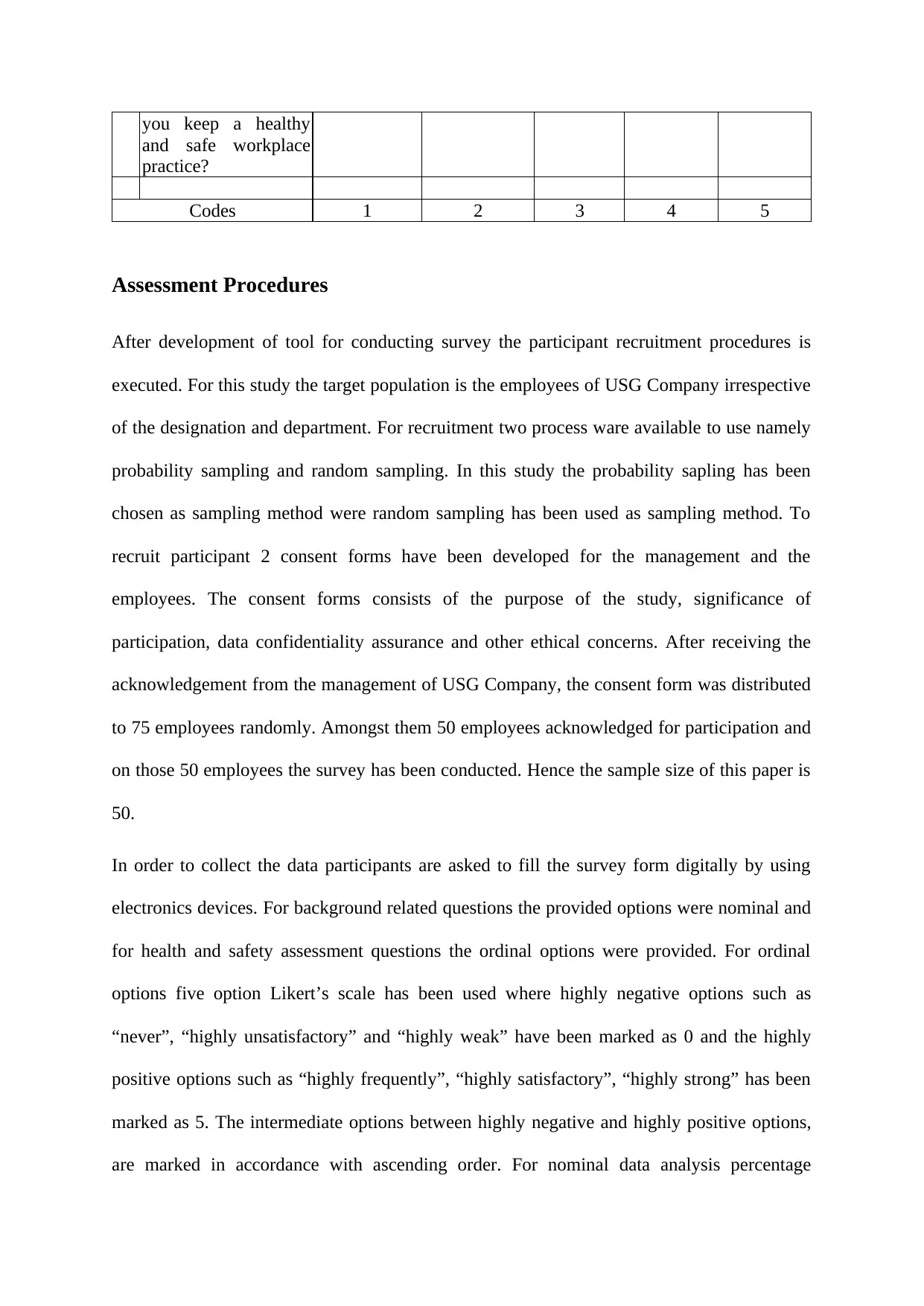
you keep a healthy
and safe workplace
practice?
Codes 1 2 3 4 5
Assessment Procedures
After development of tool for conducting survey the participant recruitment procedures is
executed. For this study the target population is the employees of USG Company irrespective
of the designation and department. For recruitment two process ware available to use namely
probability sampling and random sampling. In this study the probability sapling has been
chosen as sampling method were random sampling has been used as sampling method. To
recruit participant 2 consent forms have been developed for the management and the
employees. The consent forms consists of the purpose of the study, significance of
participation, data confidentiality assurance and other ethical concerns. After receiving the
acknowledgement from the management of USG Company, the consent form was distributed
to 75 employees randomly. Amongst them 50 employees acknowledged for participation and
on those 50 employees the survey has been conducted. Hence the sample size of this paper is
50.
In order to collect the data participants are asked to fill the survey form digitally by using
electronics devices. For background related questions the provided options were nominal and
for health and safety assessment questions the ordinal options were provided. For ordinal
options five option Likert’s scale has been used where highly negative options such as
“never”, “highly unsatisfactory” and “highly weak” have been marked as 0 and the highly
positive options such as “highly frequently”, “highly satisfactory”, “highly strong” has been
marked as 5. The intermediate options between highly negative and highly positive options,
are marked in accordance with ascending order. For nominal data analysis percentage
and safe workplace
practice?
Codes 1 2 3 4 5
Assessment Procedures
After development of tool for conducting survey the participant recruitment procedures is
executed. For this study the target population is the employees of USG Company irrespective
of the designation and department. For recruitment two process ware available to use namely
probability sampling and random sampling. In this study the probability sapling has been
chosen as sampling method were random sampling has been used as sampling method. To
recruit participant 2 consent forms have been developed for the management and the
employees. The consent forms consists of the purpose of the study, significance of
participation, data confidentiality assurance and other ethical concerns. After receiving the
acknowledgement from the management of USG Company, the consent form was distributed
to 75 employees randomly. Amongst them 50 employees acknowledged for participation and
on those 50 employees the survey has been conducted. Hence the sample size of this paper is
50.
In order to collect the data participants are asked to fill the survey form digitally by using
electronics devices. For background related questions the provided options were nominal and
for health and safety assessment questions the ordinal options were provided. For ordinal
options five option Likert’s scale has been used where highly negative options such as
“never”, “highly unsatisfactory” and “highly weak” have been marked as 0 and the highly
positive options such as “highly frequently”, “highly satisfactory”, “highly strong” has been
marked as 5. The intermediate options between highly negative and highly positive options,
are marked in accordance with ascending order. For nominal data analysis percentage
⊘ This is a preview!⊘
Do you want full access?
Subscribe today to unlock all pages.

Trusted by 1+ million students worldwide
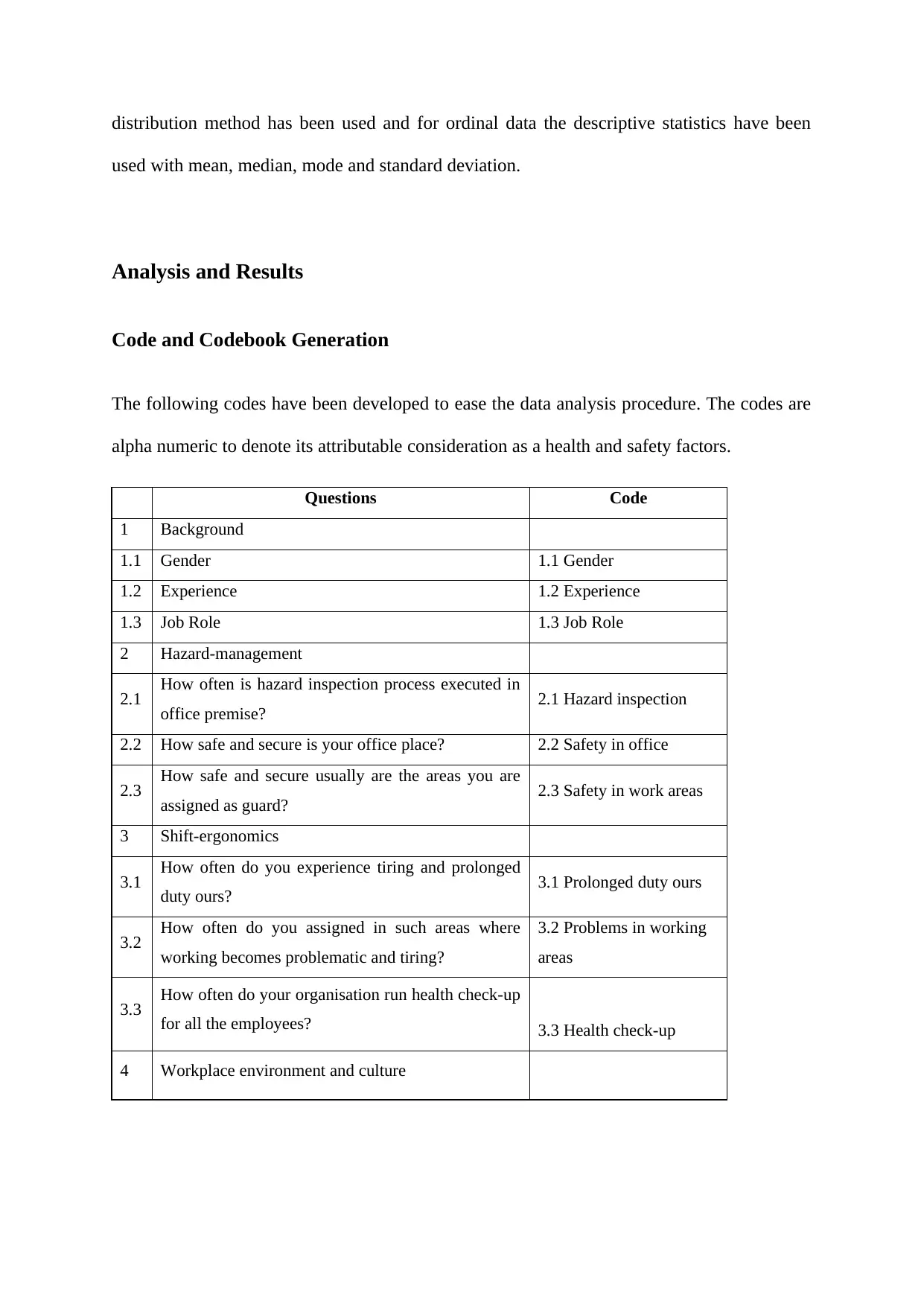
distribution method has been used and for ordinal data the descriptive statistics have been
used with mean, median, mode and standard deviation.
Analysis and Results
Code and Codebook Generation
The following codes have been developed to ease the data analysis procedure. The codes are
alpha numeric to denote its attributable consideration as a health and safety factors.
Questions Code
1 Background
1.1 Gender 1.1 Gender
1.2 Experience 1.2 Experience
1.3 Job Role 1.3 Job Role
2 Hazard-management
2.1 How often is hazard inspection process executed in
office premise? 2.1 Hazard inspection
2.2 How safe and secure is your office place? 2.2 Safety in office
2.3 How safe and secure usually are the areas you are
assigned as guard? 2.3 Safety in work areas
3 Shift-ergonomics
3.1 How often do you experience tiring and prolonged
duty ours? 3.1 Prolonged duty ours
3.2 How often do you assigned in such areas where
working becomes problematic and tiring?
3.2 Problems in working
areas
3.3 How often do your organisation run health check-up
for all the employees? 3.3 Health check-up
4 Workplace environment and culture
used with mean, median, mode and standard deviation.
Analysis and Results
Code and Codebook Generation
The following codes have been developed to ease the data analysis procedure. The codes are
alpha numeric to denote its attributable consideration as a health and safety factors.
Questions Code
1 Background
1.1 Gender 1.1 Gender
1.2 Experience 1.2 Experience
1.3 Job Role 1.3 Job Role
2 Hazard-management
2.1 How often is hazard inspection process executed in
office premise? 2.1 Hazard inspection
2.2 How safe and secure is your office place? 2.2 Safety in office
2.3 How safe and secure usually are the areas you are
assigned as guard? 2.3 Safety in work areas
3 Shift-ergonomics
3.1 How often do you experience tiring and prolonged
duty ours? 3.1 Prolonged duty ours
3.2 How often do you assigned in such areas where
working becomes problematic and tiring?
3.2 Problems in working
areas
3.3 How often do your organisation run health check-up
for all the employees? 3.3 Health check-up
4 Workplace environment and culture
Paraphrase This Document
Need a fresh take? Get an instant paraphrase of this document with our AI Paraphraser
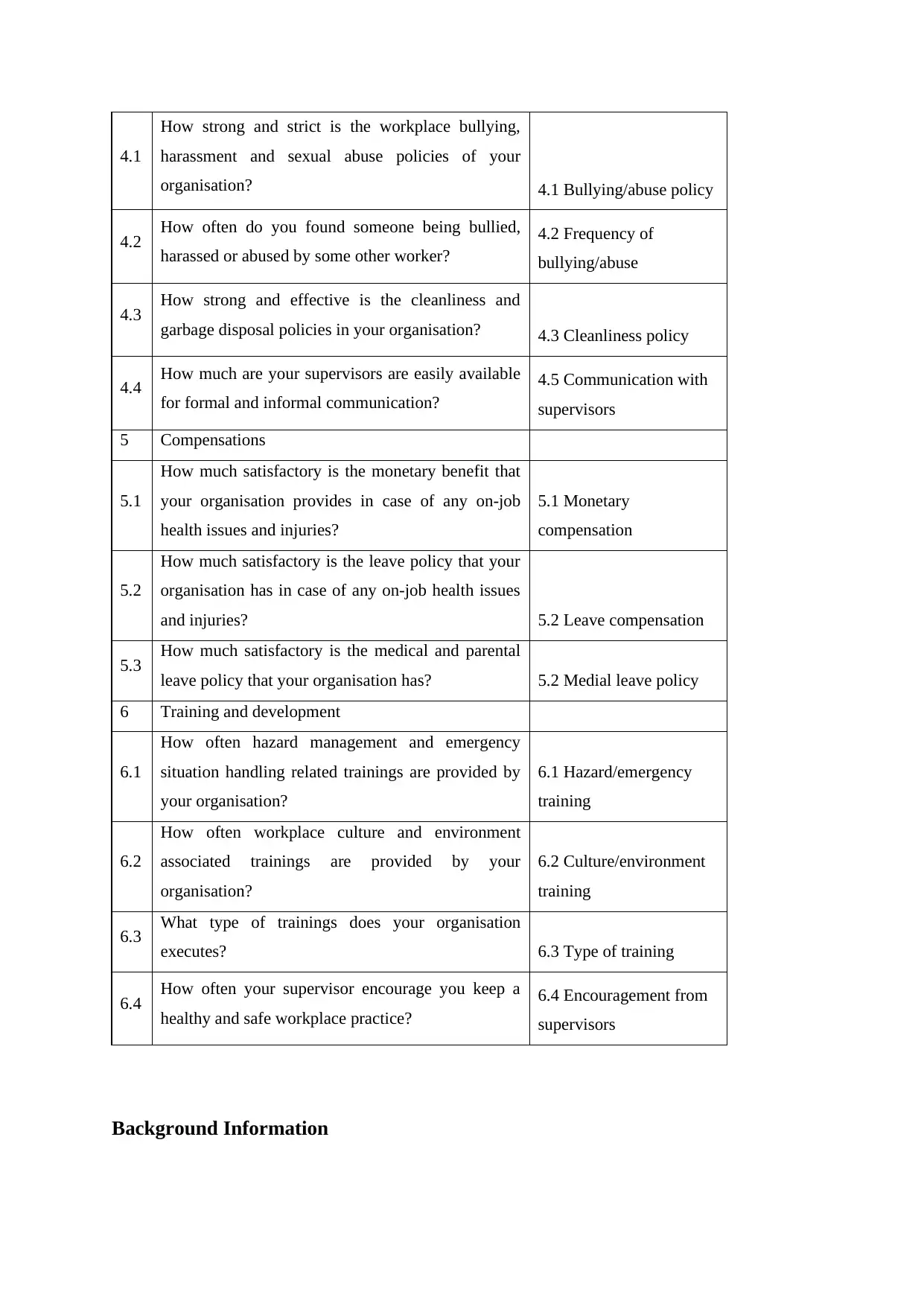
4.1
How strong and strict is the workplace bullying,
harassment and sexual abuse policies of your
organisation? 4.1 Bullying/abuse policy
4.2 How often do you found someone being bullied,
harassed or abused by some other worker?
4.2 Frequency of
bullying/abuse
4.3 How strong and effective is the cleanliness and
garbage disposal policies in your organisation? 4.3 Cleanliness policy
4.4 How much are your supervisors are easily available
for formal and informal communication?
4.5 Communication with
supervisors
5 Compensations
5.1
How much satisfactory is the monetary benefit that
your organisation provides in case of any on-job
health issues and injuries?
5.1 Monetary
compensation
5.2
How much satisfactory is the leave policy that your
organisation has in case of any on-job health issues
and injuries? 5.2 Leave compensation
5.3 How much satisfactory is the medical and parental
leave policy that your organisation has? 5.2 Medial leave policy
6 Training and development
6.1
How often hazard management and emergency
situation handling related trainings are provided by
your organisation?
6.1 Hazard/emergency
training
6.2
How often workplace culture and environment
associated trainings are provided by your
organisation?
6.2 Culture/environment
training
6.3 What type of trainings does your organisation
executes? 6.3 Type of training
6.4 How often your supervisor encourage you keep a
healthy and safe workplace practice?
6.4 Encouragement from
supervisors
Background Information
How strong and strict is the workplace bullying,
harassment and sexual abuse policies of your
organisation? 4.1 Bullying/abuse policy
4.2 How often do you found someone being bullied,
harassed or abused by some other worker?
4.2 Frequency of
bullying/abuse
4.3 How strong and effective is the cleanliness and
garbage disposal policies in your organisation? 4.3 Cleanliness policy
4.4 How much are your supervisors are easily available
for formal and informal communication?
4.5 Communication with
supervisors
5 Compensations
5.1
How much satisfactory is the monetary benefit that
your organisation provides in case of any on-job
health issues and injuries?
5.1 Monetary
compensation
5.2
How much satisfactory is the leave policy that your
organisation has in case of any on-job health issues
and injuries? 5.2 Leave compensation
5.3 How much satisfactory is the medical and parental
leave policy that your organisation has? 5.2 Medial leave policy
6 Training and development
6.1
How often hazard management and emergency
situation handling related trainings are provided by
your organisation?
6.1 Hazard/emergency
training
6.2
How often workplace culture and environment
associated trainings are provided by your
organisation?
6.2 Culture/environment
training
6.3 What type of trainings does your organisation
executes? 6.3 Type of training
6.4 How often your supervisor encourage you keep a
healthy and safe workplace practice?
6.4 Encouragement from
supervisors
Background Information
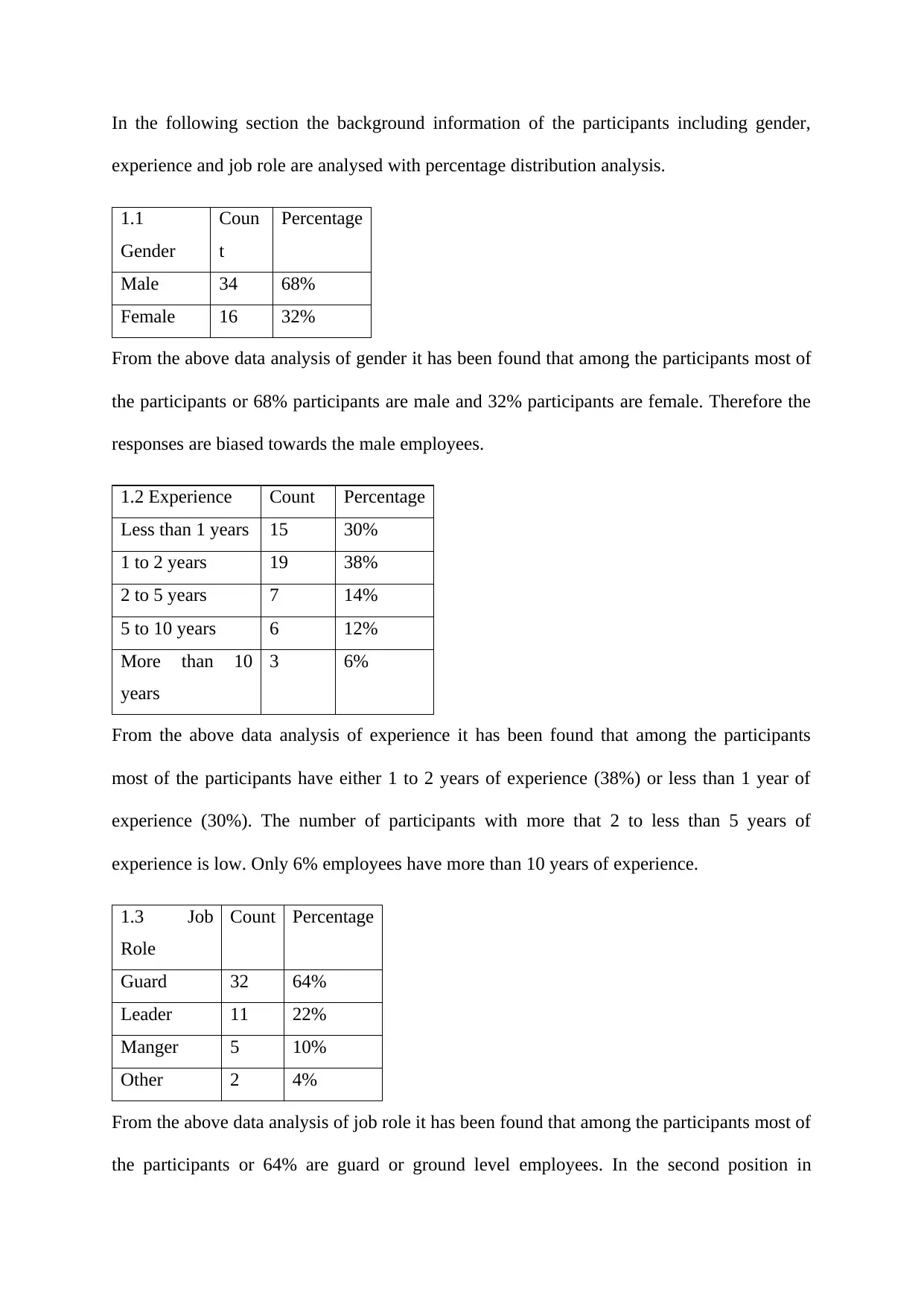
In the following section the background information of the participants including gender,
experience and job role are analysed with percentage distribution analysis.
1.1
Gender
Coun
t
Percentage
Male 34 68%
Female 16 32%
From the above data analysis of gender it has been found that among the participants most of
the participants or 68% participants are male and 32% participants are female. Therefore the
responses are biased towards the male employees.
1.2 Experience Count Percentage
Less than 1 years 15 30%
1 to 2 years 19 38%
2 to 5 years 7 14%
5 to 10 years 6 12%
More than 10
years
3 6%
From the above data analysis of experience it has been found that among the participants
most of the participants have either 1 to 2 years of experience (38%) or less than 1 year of
experience (30%). The number of participants with more that 2 to less than 5 years of
experience is low. Only 6% employees have more than 10 years of experience.
1.3 Job
Role
Count Percentage
Guard 32 64%
Leader 11 22%
Manger 5 10%
Other 2 4%
From the above data analysis of job role it has been found that among the participants most of
the participants or 64% are guard or ground level employees. In the second position in
experience and job role are analysed with percentage distribution analysis.
1.1
Gender
Coun
t
Percentage
Male 34 68%
Female 16 32%
From the above data analysis of gender it has been found that among the participants most of
the participants or 68% participants are male and 32% participants are female. Therefore the
responses are biased towards the male employees.
1.2 Experience Count Percentage
Less than 1 years 15 30%
1 to 2 years 19 38%
2 to 5 years 7 14%
5 to 10 years 6 12%
More than 10
years
3 6%
From the above data analysis of experience it has been found that among the participants
most of the participants have either 1 to 2 years of experience (38%) or less than 1 year of
experience (30%). The number of participants with more that 2 to less than 5 years of
experience is low. Only 6% employees have more than 10 years of experience.
1.3 Job
Role
Count Percentage
Guard 32 64%
Leader 11 22%
Manger 5 10%
Other 2 4%
From the above data analysis of job role it has been found that among the participants most of
the participants or 64% are guard or ground level employees. In the second position in
⊘ This is a preview!⊘
Do you want full access?
Subscribe today to unlock all pages.

Trusted by 1+ million students worldwide
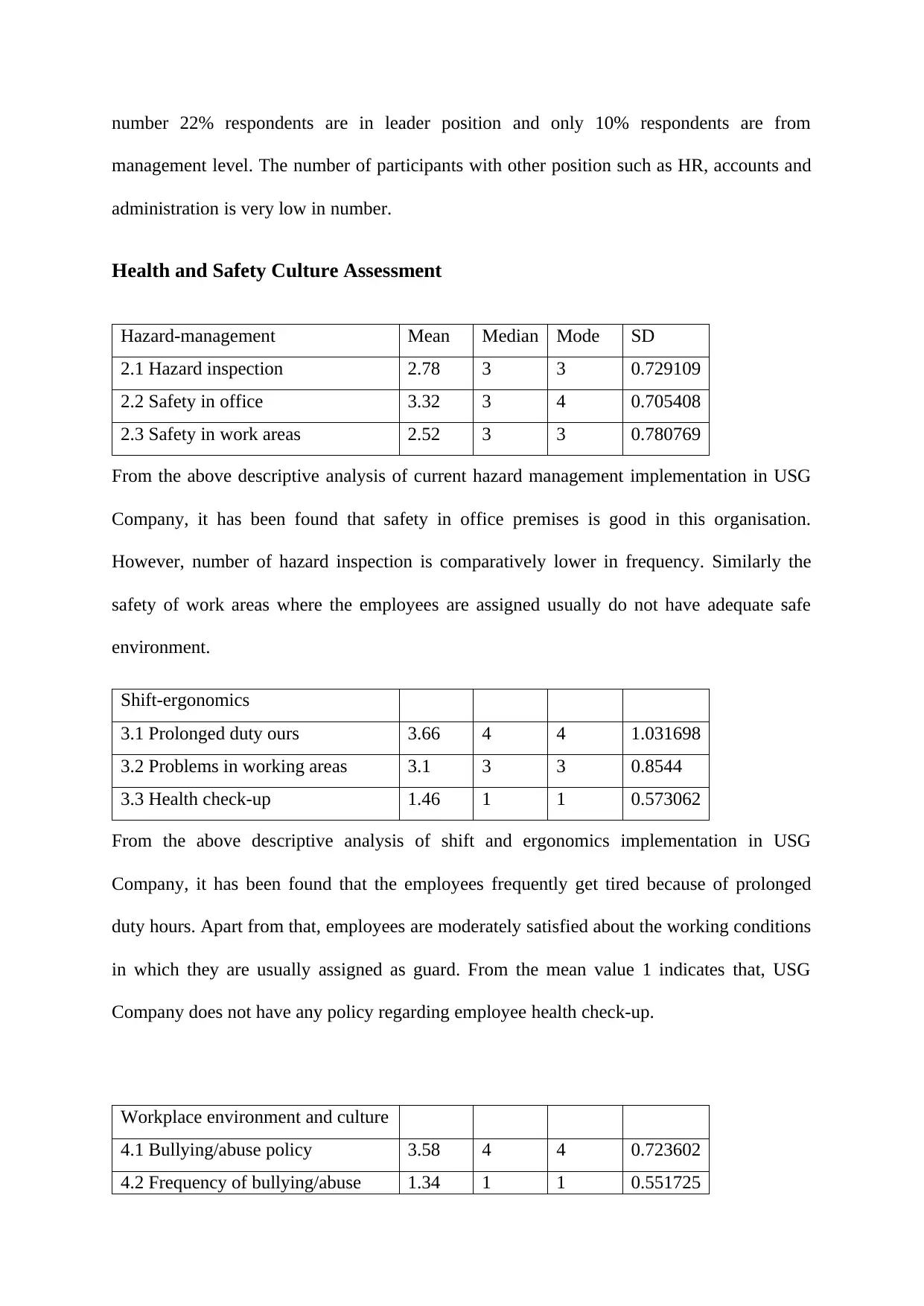
number 22% respondents are in leader position and only 10% respondents are from
management level. The number of participants with other position such as HR, accounts and
administration is very low in number.
Health and Safety Culture Assessment
Hazard-management Mean Median Mode SD
2.1 Hazard inspection 2.78 3 3 0.729109
2.2 Safety in office 3.32 3 4 0.705408
2.3 Safety in work areas 2.52 3 3 0.780769
From the above descriptive analysis of current hazard management implementation in USG
Company, it has been found that safety in office premises is good in this organisation.
However, number of hazard inspection is comparatively lower in frequency. Similarly the
safety of work areas where the employees are assigned usually do not have adequate safe
environment.
Shift-ergonomics
3.1 Prolonged duty ours 3.66 4 4 1.031698
3.2 Problems in working areas 3.1 3 3 0.8544
3.3 Health check-up 1.46 1 1 0.573062
From the above descriptive analysis of shift and ergonomics implementation in USG
Company, it has been found that the employees frequently get tired because of prolonged
duty hours. Apart from that, employees are moderately satisfied about the working conditions
in which they are usually assigned as guard. From the mean value 1 indicates that, USG
Company does not have any policy regarding employee health check-up.
Workplace environment and culture
4.1 Bullying/abuse policy 3.58 4 4 0.723602
4.2 Frequency of bullying/abuse 1.34 1 1 0.551725
management level. The number of participants with other position such as HR, accounts and
administration is very low in number.
Health and Safety Culture Assessment
Hazard-management Mean Median Mode SD
2.1 Hazard inspection 2.78 3 3 0.729109
2.2 Safety in office 3.32 3 4 0.705408
2.3 Safety in work areas 2.52 3 3 0.780769
From the above descriptive analysis of current hazard management implementation in USG
Company, it has been found that safety in office premises is good in this organisation.
However, number of hazard inspection is comparatively lower in frequency. Similarly the
safety of work areas where the employees are assigned usually do not have adequate safe
environment.
Shift-ergonomics
3.1 Prolonged duty ours 3.66 4 4 1.031698
3.2 Problems in working areas 3.1 3 3 0.8544
3.3 Health check-up 1.46 1 1 0.573062
From the above descriptive analysis of shift and ergonomics implementation in USG
Company, it has been found that the employees frequently get tired because of prolonged
duty hours. Apart from that, employees are moderately satisfied about the working conditions
in which they are usually assigned as guard. From the mean value 1 indicates that, USG
Company does not have any policy regarding employee health check-up.
Workplace environment and culture
4.1 Bullying/abuse policy 3.58 4 4 0.723602
4.2 Frequency of bullying/abuse 1.34 1 1 0.551725
Paraphrase This Document
Need a fresh take? Get an instant paraphrase of this document with our AI Paraphraser
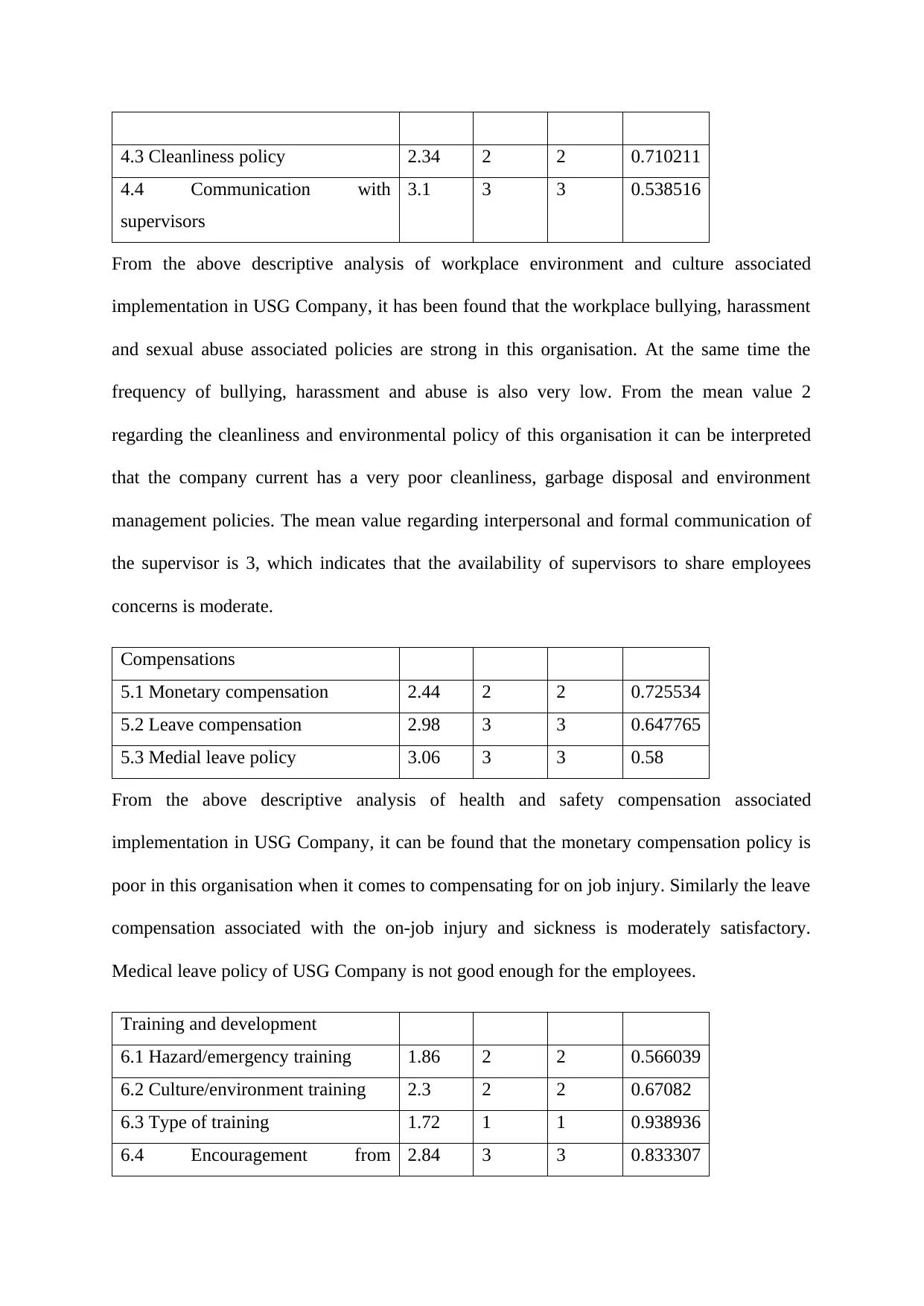
4.3 Cleanliness policy 2.34 2 2 0.710211
4.4 Communication with
supervisors
3.1 3 3 0.538516
From the above descriptive analysis of workplace environment and culture associated
implementation in USG Company, it has been found that the workplace bullying, harassment
and sexual abuse associated policies are strong in this organisation. At the same time the
frequency of bullying, harassment and abuse is also very low. From the mean value 2
regarding the cleanliness and environmental policy of this organisation it can be interpreted
that the company current has a very poor cleanliness, garbage disposal and environment
management policies. The mean value regarding interpersonal and formal communication of
the supervisor is 3, which indicates that the availability of supervisors to share employees
concerns is moderate.
Compensations
5.1 Monetary compensation 2.44 2 2 0.725534
5.2 Leave compensation 2.98 3 3 0.647765
5.3 Medial leave policy 3.06 3 3 0.58
From the above descriptive analysis of health and safety compensation associated
implementation in USG Company, it can be found that the monetary compensation policy is
poor in this organisation when it comes to compensating for on job injury. Similarly the leave
compensation associated with the on-job injury and sickness is moderately satisfactory.
Medical leave policy of USG Company is not good enough for the employees.
Training and development
6.1 Hazard/emergency training 1.86 2 2 0.566039
6.2 Culture/environment training 2.3 2 2 0.67082
6.3 Type of training 1.72 1 1 0.938936
6.4 Encouragement from 2.84 3 3 0.833307
4.4 Communication with
supervisors
3.1 3 3 0.538516
From the above descriptive analysis of workplace environment and culture associated
implementation in USG Company, it has been found that the workplace bullying, harassment
and sexual abuse associated policies are strong in this organisation. At the same time the
frequency of bullying, harassment and abuse is also very low. From the mean value 2
regarding the cleanliness and environmental policy of this organisation it can be interpreted
that the company current has a very poor cleanliness, garbage disposal and environment
management policies. The mean value regarding interpersonal and formal communication of
the supervisor is 3, which indicates that the availability of supervisors to share employees
concerns is moderate.
Compensations
5.1 Monetary compensation 2.44 2 2 0.725534
5.2 Leave compensation 2.98 3 3 0.647765
5.3 Medial leave policy 3.06 3 3 0.58
From the above descriptive analysis of health and safety compensation associated
implementation in USG Company, it can be found that the monetary compensation policy is
poor in this organisation when it comes to compensating for on job injury. Similarly the leave
compensation associated with the on-job injury and sickness is moderately satisfactory.
Medical leave policy of USG Company is not good enough for the employees.
Training and development
6.1 Hazard/emergency training 1.86 2 2 0.566039
6.2 Culture/environment training 2.3 2 2 0.67082
6.3 Type of training 1.72 1 1 0.938936
6.4 Encouragement from 2.84 3 3 0.833307
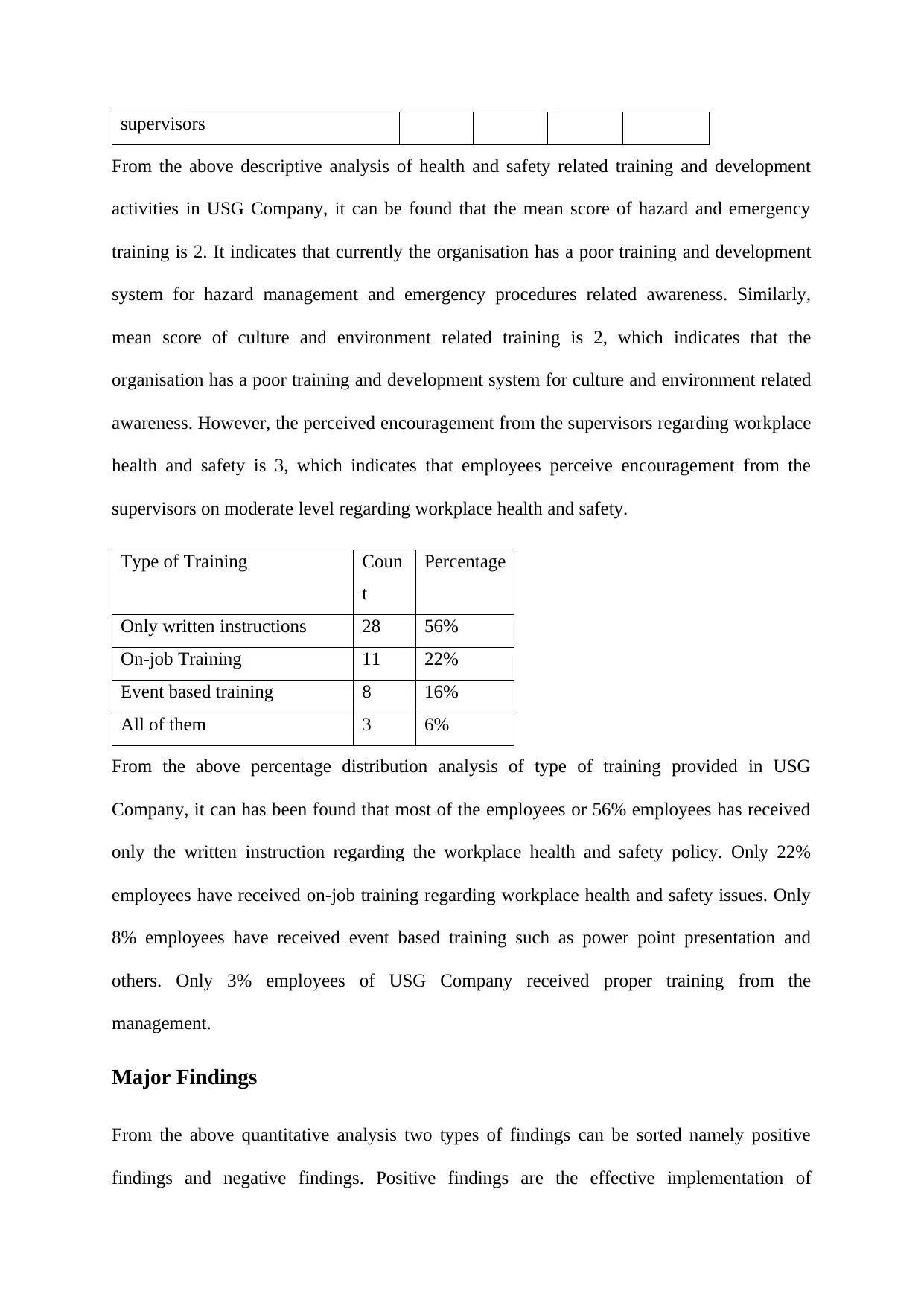
supervisors
From the above descriptive analysis of health and safety related training and development
activities in USG Company, it can be found that the mean score of hazard and emergency
training is 2. It indicates that currently the organisation has a poor training and development
system for hazard management and emergency procedures related awareness. Similarly,
mean score of culture and environment related training is 2, which indicates that the
organisation has a poor training and development system for culture and environment related
awareness. However, the perceived encouragement from the supervisors regarding workplace
health and safety is 3, which indicates that employees perceive encouragement from the
supervisors on moderate level regarding workplace health and safety.
Type of Training Coun
t
Percentage
Only written instructions 28 56%
On-job Training 11 22%
Event based training 8 16%
All of them 3 6%
From the above percentage distribution analysis of type of training provided in USG
Company, it can has been found that most of the employees or 56% employees has received
only the written instruction regarding the workplace health and safety policy. Only 22%
employees have received on-job training regarding workplace health and safety issues. Only
8% employees have received event based training such as power point presentation and
others. Only 3% employees of USG Company received proper training from the
management.
Major Findings
From the above quantitative analysis two types of findings can be sorted namely positive
findings and negative findings. Positive findings are the effective implementation of
From the above descriptive analysis of health and safety related training and development
activities in USG Company, it can be found that the mean score of hazard and emergency
training is 2. It indicates that currently the organisation has a poor training and development
system for hazard management and emergency procedures related awareness. Similarly,
mean score of culture and environment related training is 2, which indicates that the
organisation has a poor training and development system for culture and environment related
awareness. However, the perceived encouragement from the supervisors regarding workplace
health and safety is 3, which indicates that employees perceive encouragement from the
supervisors on moderate level regarding workplace health and safety.
Type of Training Coun
t
Percentage
Only written instructions 28 56%
On-job Training 11 22%
Event based training 8 16%
All of them 3 6%
From the above percentage distribution analysis of type of training provided in USG
Company, it can has been found that most of the employees or 56% employees has received
only the written instruction regarding the workplace health and safety policy. Only 22%
employees have received on-job training regarding workplace health and safety issues. Only
8% employees have received event based training such as power point presentation and
others. Only 3% employees of USG Company received proper training from the
management.
Major Findings
From the above quantitative analysis two types of findings can be sorted namely positive
findings and negative findings. Positive findings are the effective implementation of
⊘ This is a preview!⊘
Do you want full access?
Subscribe today to unlock all pages.

Trusted by 1+ million students worldwide
1 out of 15
Related Documents
Your All-in-One AI-Powered Toolkit for Academic Success.
+13062052269
info@desklib.com
Available 24*7 on WhatsApp / Email
![[object Object]](/_next/static/media/star-bottom.7253800d.svg)
Unlock your academic potential
Copyright © 2020–2025 A2Z Services. All Rights Reserved. Developed and managed by ZUCOL.




